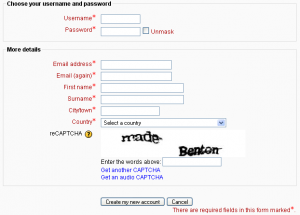Diferencia entre revisiones de «Auto-registro basado en Email»
m (added page) |
m (tidy up) |
||
| Línea 3: | Línea 3: | ||
El método de autenticación por auto registro basado en Email le permite a los usuarios crear sus propias cuentas mediante el botón para 'Crear nueva cuenta' en la página de entrada al sitio. Los usuarios recibirán un Email en la dirección que especificaron en el perfil de su cuenta al confirmarla. | El método de autenticación por auto registro basado en Email le permite a los usuarios crear sus propias cuentas mediante el botón para 'Crear nueva cuenta' en la página de entrada al sitio. Los usuarios recibirán un Email en la dirección que especificaron en el perfil de su cuenta al confirmarla. | ||
Nota importante: Es conveniente advertirles a los usuarios que vayan a registrarse que en ocasiones los servidores Moodle envían tal cantidad de Emails que los servicios de correos electrónicos | '''Nota importante:''' Es conveniente advertirles a los usuarios que vayan a registrarse que en ocasiones los servidores Moodle envían tal cantidad de Emails que los servicios de correos electrónicos pueden clasificar estos mensajes como SPAM, por lo que deberán revisar su carpeta de SPAM, por si el mensaje de confirmación de registro en Moodle hubiera sido enviado allí. | ||
[[File:Emailbased.png]] | [[File:Emailbased.png]] | ||
Revisión del 01:10 19 mar 2013
El método de autenticación por auto registro basado en Email le permite a los usuarios crear sus propias cuentas mediante el botón para 'Crear nueva cuenta' en la página de entrada al sitio. Los usuarios recibirán un Email en la dirección que especificaron en el perfil de su cuenta al confirmarla.
Nota importante: Es conveniente advertirles a los usuarios que vayan a registrarse que en ocasiones los servidores Moodle envían tal cantidad de Emails que los servicios de correos electrónicos pueden clasificar estos mensajes como SPAM, por lo que deberán revisar su carpeta de SPAM, por si el mensaje de confirmación de registro en Moodle hubiera sido enviado allí.
Habilitando el auto-registro basado en Email
An administrator can enable email-based self-registration in Settings > Site administration > Plugins > Authentication > Manage authentication.
In addition to enabling the plugin, email-based self-registration must be selected from the self registration drop-down menu in the common settings.
Warning: Enabling self registration results in the possibility of spammers creating accounts in order to use forum posts, blog entries etc. for spam. This risk can be minimized by limiting self registration to particular email domains with the allowed email domains setting in Settings > Site administration > Plugins> Authentication > Manage authentication. Alternatively, self registration may be enabled for a short period of time to allow users to create accounts, and then later disabled.
Note: The Email-based self-registration authentication plugin must be enabled to allow users who previously self-registered to login. Selecting Email-based self-registration as the self registration method allows potential users to self register.
Habilitando elemento reCAPTCHA
A CAPTCHA is a program that can tell whether its user is a human or a computer. CAPTCHAs are used by many websites to prevent abuse from bots, or automated programs usually written to generate spam. No computer program can read distorted text as well as humans can, so bots cannot navigate sites protected by CAPTCHAs.
Spam protection may be added to the email-based self-registration new account form with a CAPTCHA element - a challenge-response test used to determine whether the user is human.
In addition to enabling the reCAPTCHA element, email-based self-registration should be set as the self registration authentication plugin and reCAPTCHA keys should be set in the manage authentication common settings.
Contacto para soporte
An administrator can specify a support name, email and/or support page in Settings > Site administration > Server > Support contact for including in the confirmation email.
Vea también
Using Moodle forum discussions:

